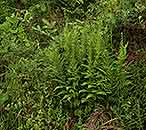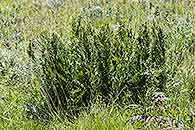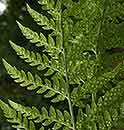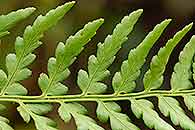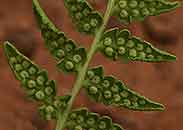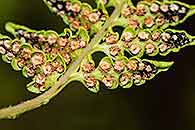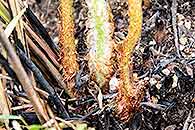Dryopteris athamantica (Kunze) Kuntze
Synonyms |
Nephrodium athamanticum (Kunze) Hook. |
|---|---|
Common name |
|
Description |
Rhizome creeping to suberect, up to 25 mm in diameter; rhizome scales reddish-brown, narrowly lanceolate to linear in outline, up to 22 x 2 mm, margins with or without filamentous outgrows. Fronds tufted, erect, rigid, subcoriaceous. Stipe stout, up to 54 x 1.4 cm, straw-coloured, darker towards the base, grooved, with scales similar to the rhizome towards the base. Lamina up to 78 × 27 cm, narrowly ovate-oblong to lanceolate in outline, 2-pinnate-pinnatifid to 3-pinnate-pinnatifid, basal pinnae hardly reduced. Pinnae up to 25 × 12 cm, up to 23 stalked pairs, usually forming an angle of less than 50° from the rhachis, narrowly triangular-oblong in outline, subglabrous on both surfaces. Pinnules narrowly oblong-lanceolate, deeply pinnatifid into oblong, obtuse ultimate lobes with shallowly crenate to subentire margins, up to 20 x 7 mm. Rhachis straw-coloured to greenish, narrowly winged towards the apex, with a few hair-like, reddish-brown scales. Sori round, discrete or touching, up to 1.6 mm in diameter at maturity, 1-3 per ultimate segment; indusia round to kidney-shaped, membranous, entire or slightly dentate, up to 1.7 mm in diameter. |
Notes | Could be confused with the sun form of D. pentheri which has an ovate-triangular lamina, pinnae angled at 70-80° from the rhachis and pinnules that are ovate to round-oblong in outline. |
Derivation | athamantis: brightness; this may refer to the preference of this species for sunny open habitats. |
Habitat | Around boulder bases or at scrub margins in montane grassland, miombo woodland, in ditches, along roads, exposed areas in full sun. |
Distribution worldwide | Tropical to subtropical Africa. |
Distribution in Africa |
Angola, Burundi, Cameroon, Central African Republic, Congo, Dem. Republic of Congo, Ethiopia, Ghana, Guinea, Ivory Coast, Kenya, Lesotho, Liberia, Malawi, Mozambique, Nigeria, Rwanda, Sierra Leone, South Africa, Sudan and South Sudan, Swaziland, Tanzania , Uganda, Zambia, Zimbabwe. |
Growth form |
Lithophytic, terrestrial. |
Literature |
|
